Once you get into bouldering, you’ll notice that the climbing world has a lot of different grading scales, depending on the country they climb in. This can be VERY confusing to a beginner boulderer.
What are bouldering grades?
Simply put, bouldering grades are a made-up system consisting mainly of letters and numbers to measure the difficulty of a boulder problem.
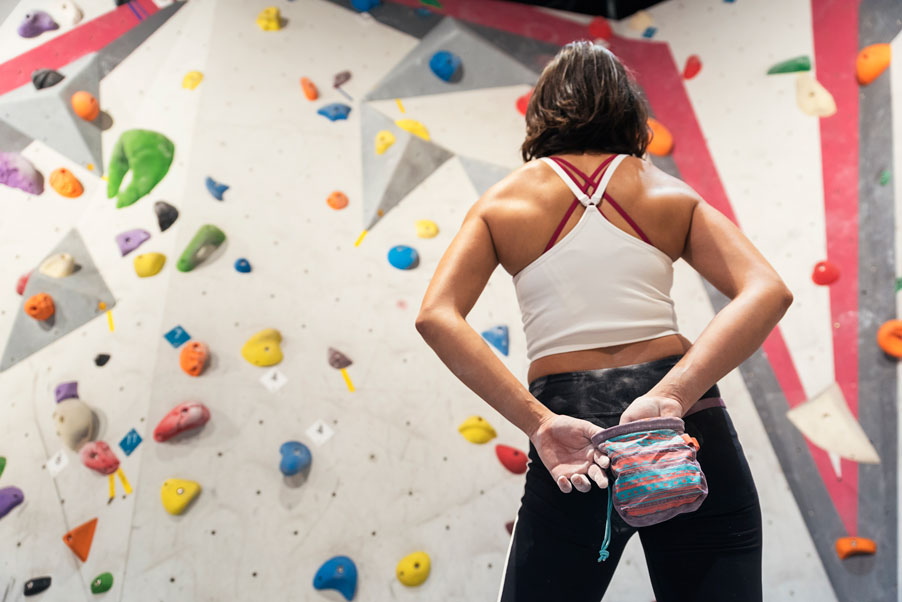
Unfortunately, bordering grades aren’t universal. Different regions in the world use different grading systems. On top of that, some indoor gyms also use their own grading system.
Bouldering grades used all over the world
Below is a list of regions alongside which bouldering grading system they use.
While sport climbing has a wide variety of grading systems used by different countries, when it comes to bouldering, most countries have adopted either the Font or V scale grading system. Except for Japan, which uses the Dankyu system, a grading system based on Martial Arts grading.
Even the United Kingdom, which uses the UK Technical Grade system for Trad Climbing and originally used the same system for bouldering, has adopted the V grading System (though sometimes they use Font, its confusing).
Australian and New Zealand boulderers have adopted the V-scale system. Though many Australian gyms (e.g. Blochaus) use their own grading system.
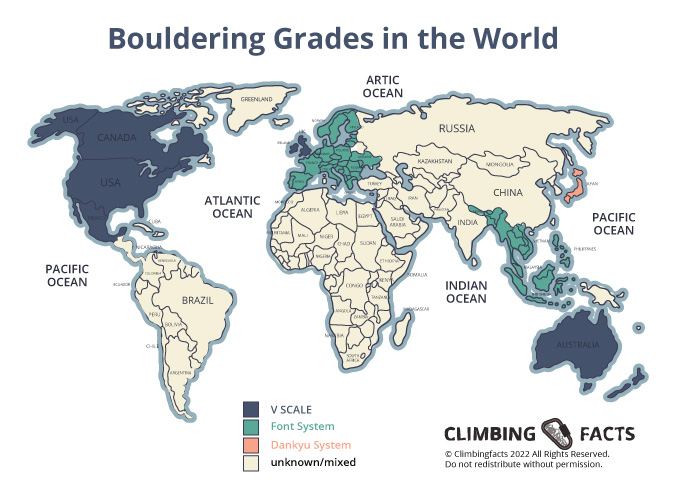
| Region | Grading System | Grade Range |
|---|---|---|
| North America (+ Australia, New Zealand, UK) | V-Scale | V0 – V17 |
| Europe | Font System | 3 – 9A |
| Japan | Dankyu System | 7 Kyuu – 5 dan |
How boulders are graded
In the outdoors, boulders are assigned a grade by whoever made the first ascent. The climber will use their experience with similarly graded boulders to assign a fitting grade. This process is entirely subjective. Some boulderers grade hard while others grade soft.
Just because the first ascensionist assigned the grade, doesn’t mean that grade will stick. Other climbers who sent the boulder might propose a lower grade (downgrade) or a higher grade (upgrade) in the future.
In indoor bouldering gyms, route setters are used to create bouldering problems. These are experienced climbers who combine creativity with expertise to create interesting routes on indoor bouldering walls with the use of holds, volumes, and their trusty electric drill.
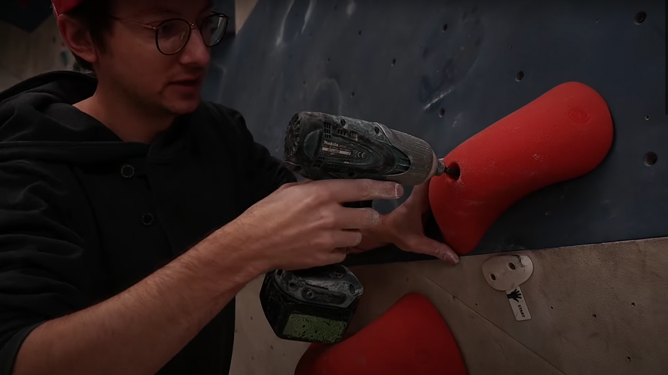
Once they have placed a route, they will send it and then assign a grade to it. In many cases, the route will be sent by other route setters or experienced climbers as well to confirm that the grade is accurate.
Due to bouldering grading being very subjective, you will often experience bouldering problems in indoor gyms that seem either graded too hard or too soft.
Two popular Boulder Grading Scales
As aforementioned, two grading scales stand out in the world right now. These are the ones you will find in any English-speaking article, video, or documentary related to climbing or bouldering.
The two bouldering grading scales in question are:
- The Font Grading System (Europe, Asia)
- The V-scale Grading System (North America)
If you want to navigate the internet for any guides, or other content related to bouldering, it would do you well to know what these two grading systems are, and how you can convert one another.
Let’s take a look at both scales.
The Font Grading System
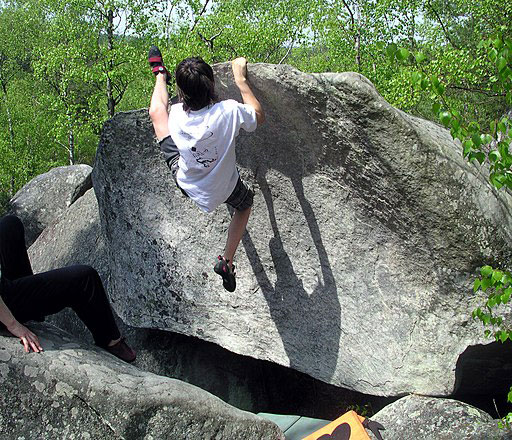
The Font Grading system is the original Bouldering Grading System. Used in most of Europe, Asia, as well as some other countries around the world.
This grading system was developed in the 60s in the Forest of Fontainebleau, a popular bouldering area in France. Font is short for Fontainebleau, hence why this grading system is called the ‘Font’ Grading System.
| Origin: | Fointainbleau, France |
| Date developed: | 1960 |
| Regions used: | Europe, Asia |
| Grade range: | 4 – 9a |
The Font Grading system is an open-ended system that ranges from 1 – 9a. However, you will never see a bouldering grade lower than 3 in a bouldering gym or lower than 4 in the outdoors. So in reality, the range is 4 – 9a.
Around grade 6 (sometimes 5), the Font grading system starts using a, b, and c to indicate different ranges of difficulty. The Font system also makes use of ‘+’ sign to indicate a slight difference in difficulty.
For example, a 7a+ is harder than a 7a.
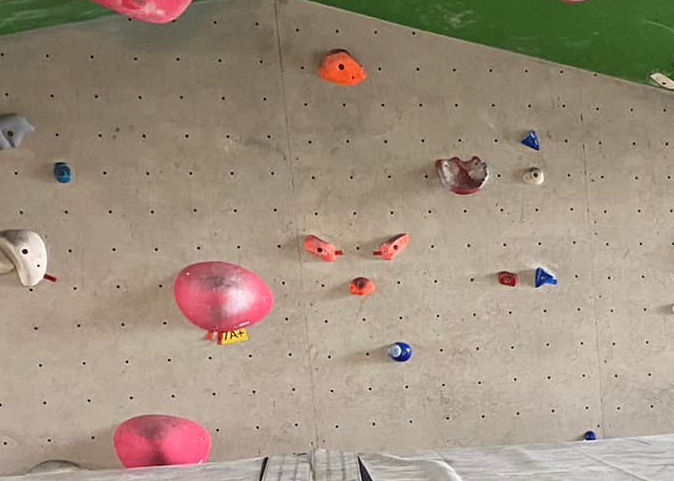
The Hueco (V) Grading System
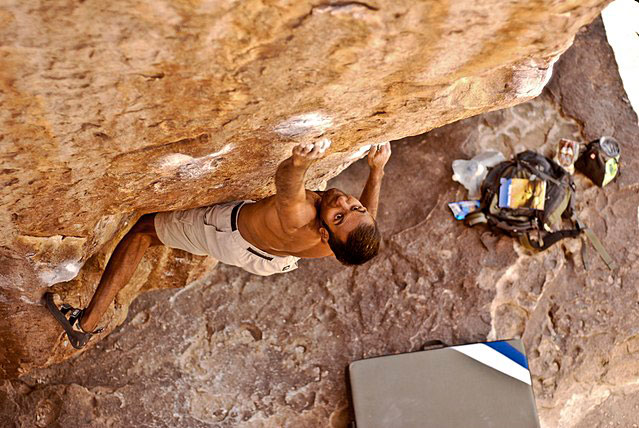
The Hueco Grading System, also known as the V-scale is a newer grading system that is used primarily in North America.
The V scale was first developed in the 90s by John Sherman while bouldering in Hueco Tanks, Texas. The ‘V’ in the V scale references the nickname of John Sherman who was known as ‘Vermin’ or ‘Verm’. The grading system is also known as the Hueco Grading System named after its place of origin.
| Origin: | Hueco Tanks, Texas |
| Date developed: | 1990 |
| Regions used: | North America + Australia/New Zealand |
| Grade range: | V0 – V17 |
Just like the Font system, the Hueco Grading system is also an open-ended system that ranges from V0 – V17. This grading scale is a lot easier to read than the Font scale which is why it is often adopted online as the main bouldering grading scale.
For example, on this site, you will often see me using the V-scale system (due to its simplicity) even though I grew up with the Font scale.
Bouldering Grades Conversion
Since most boulderers wind up using either the font scale or the V-scale when they start climbing, they may need to use a bouldering conversion table when they go bouldering abroad.
Bouldering Grades Conversion Chart Font to V-Scale
Below is a conversion chart for bouldering grades that converts font scale bouldering grades into v-scale grades and vice versa.
| Font Scale (Europe/Asia) | V-Scale (North America) |
|---|---|
| 4 | V0 |
| 5 | V1 |
| 5+ (5b/5c) | V2 |
| 6a 6a+ | V3 |
| 6b 6b+ | V4 |
| 6c 6c+ | V5 |
| 7a | V6 |
| 7a+ | V7 |
| 7b 7b+ | V8 |
| 7c | V9 |
| 7c+ | V10 |
| 8a | V11 |
| 8a+ | V12 |
| 8b | V13 |
| 8b+ | V14 |
| 8c | V15 |
| 8c+ | V16 |
| 9a | V17 |
If you want to have a bouldering conversion chart on hand, you can save our infographic below.
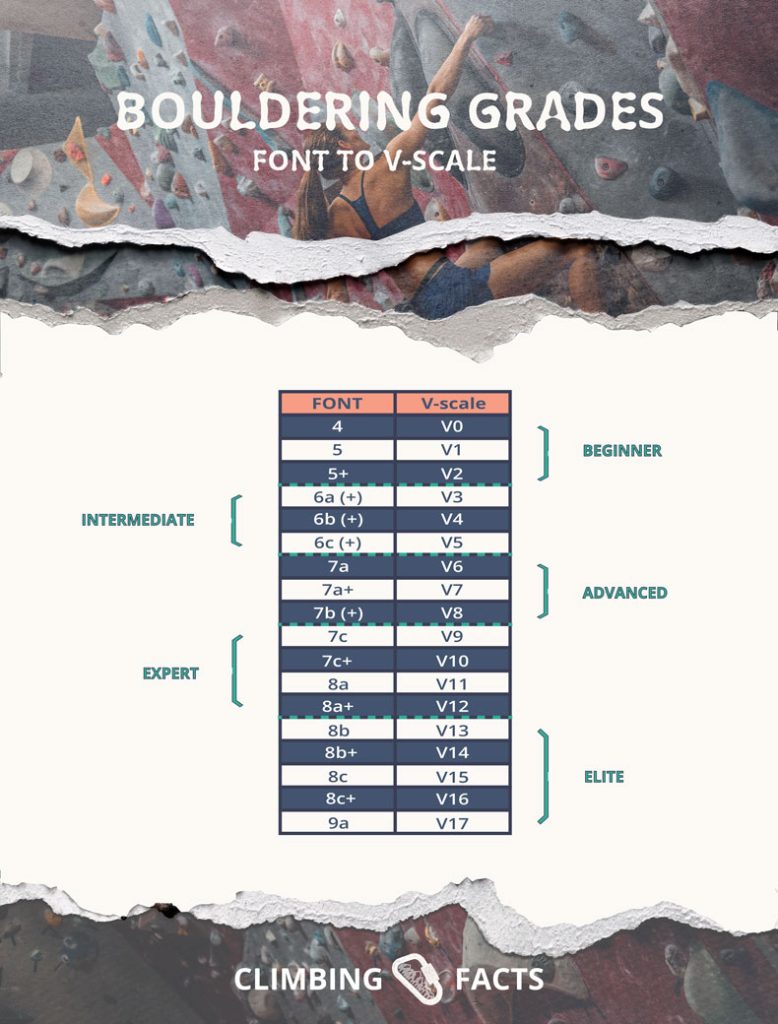
Different Bouldering Grade Levels
To make the grades easier to read, climbers assign levels to different grading ranges. Just like bouldering grades, these ‘levels’ are subjective. What some might consider an intermediate grade, others might find it an advanced grade.
Subjectivity aside, most climbers agree that V0 – V2 are beginner levels and anything over V13 is expert territory.
Beginner Grades: 4 – 5+ / V0 – V2
The beginner grades are every boulderer’s starting point. As a newbie, you will spend a couple of weeks or months on the beginner grades before you feel ready to advance to the intermediate grades.
As an introduction to bouldering, these problems tend to have big holds within safe reach of each other. A common mistake is to rush these boulders and attempt to advance the intermediate grades too soon. This is a bad idea as this grade range allows your body to adapt to your new hobby. Rushing to higher grades may lead to injury or disappointment.
Intermediate Grades: 6a – 6c / V3 – V5
Most boulderers will progress to intermediate grades after a couple of months of training indoors.
At this point, your body has adapted to climbing. You have built up some muscle memory as well as some finger strength to approach those crimpy holds that come with the intermediate grades.
At this point, the boulder problems become more difficult to read. The holds get crimpier (say goodbye to those nice jugs) and your footwork is finally being tested. You will definitely need some beta when reaching this grade range. Making friends with boulderers experienced in this grade range will largely benefit your progression through the intermediate levels.
I consider the intermediate grades a bottleneck as many boulderers find themselves stuck in this grade range for a long time. This is also the point where your love for climbing is being tested. Are you someone who wants to progress quickly to feed your ego? Or do you truly love climbing?
Advanced Grades: 7a – 7b+ / V6 – V8
Reaching advanced grades is always a turning point for boulderers. At this point there is no mistaking: climbing is a big part of your life. You worked hard to get here, and you should be damn proud of it. Climbers look up to you at your local bouldering gym and sometimes route setters might even set up problems specifically for you.
Expert Grades: 7c – 8a+ / V9 – V12
At this point, climbing is no longer a hobby, it is a lifestyle. Any free time they have is likely spent either climbing or training for climbing. Your travels are almost certainly climbing-related. A trip to France isn’t going to be a romantic city trip, instead of tasting wine and soaking up the culture, you’ll spend all your hours crushing boulders at Fontainebleau.
Elite Grades: 8b/V13 and above
This is the grade range that only a select few boulderers will ever reach in their lifetime. To date, less than 50 climbers have been able to sent a 8c boulder problem or above.
At this point, climbing is your full-time job. Companies sponsor you and climbing media is constantly looking to interview you.
Some notable Elite level boulderers:
- Nalle Hukkataival
- Daniel Woods
- Jimmy Webb
- David Graham
- Adam Ondra
Converting Font-Scale to V-Scale
4 (font) to V-scale
A 4 bouldering grade in font converts to a V0 in the Hueco Grading System.
5 (font) to V-scale
A 5 Font bouldering grade converts to a V1 in the v scale. A 5+ (sometimes graded as 5b or 5c) can be converted into a V2 bouldering grade on the V-scale.
6a to V-scale
Both 6a and 6a+ graded boulders in the font system convert into a V3 bouldering grade in the North American V-scale.
6b to V-scale
Both 6b and 6b+ graded boulders in the Fontainebleau system convert into a V4 grade in the V-scale bouldering grading system.
6c to V-scale
Both 6c and 6c+ in Font, convert to a V5 bouldering grade in the V-scale system.
7a to V-scale
A 7a in font bouldering grade can be converted into a V6 bouldering grade. While a 7a+ can be converted into a v7 bouldering grace.
7b to V-scale
Both 7b and 7b+ in the font scale are converted into a V8 in the Hueco Grading System.
7c to V-scale
A 7c in the Font scale converts to a V9 in the V-scale. A 7c+ however, is more similar to the V10 bouldering grade in the V-scale.
8a to V-scale
An 8a bouldering grade on the Font Scale, converts to a V11 bouldering grade in the V-scale. However, 8a+ converts to a V12.
8b to V-scale
An 8b in the Font grading system converts into a V13 in the Hueco grading system for bouldering. And an 8b+ graded boulder converts to a V14 grade in the v-scale.
8c to V-scale
An 8c graded boulder in the Font Grading System converts to a V15 in the Hueco Grading System. An 8c+ boulder problem, however, converts to a V16 grade.
9a to V-scale
A 9a bouldering grade in the font system converts to a V17 in the Hueco Grading System.
Conversion: Indoor to Outdoor Bouldering Grades
Indoor and outdoor bouldering grades are not one and the same. If they were, then bouldering would have a huge learning curve and the sport wouldn’t be as accessible and beginner-friendly.
An indoor V0 boulder problem does not equal its outdoor counterpart with the same grade. An outdoor V0 feels closer to an indoor V2 than a V0. This is because route setters at indoor bouldering gyms tend to make the grades a lot easier to accommodate beginners and allow them to progress faster.
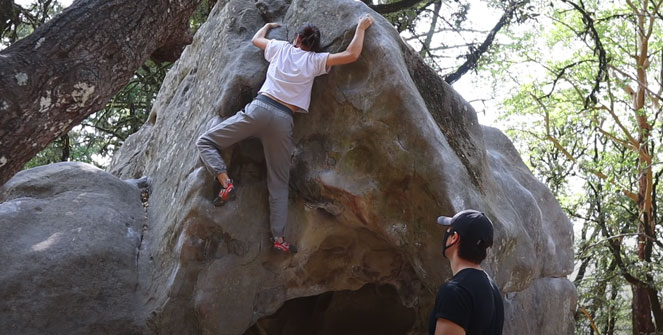
This is especially so in the beginner grade levels V0 – V4. Once you go higher in the grade range (V5 and up), indoor bouldering grades tend to more closely resemble their outdoor counterparts.
| Indoor V-Scale | Outdoor V-Scale |
|---|---|
| V0 | / |
| V1 | / |
| V2 | V0 |
| V3 | V1 |
| V4 | V2 |
| V5 | V3 V4 |
| V6 | V4 V5 |
| V7 | V6 |
| V8 | V7 |
| V9 | V8 |
| V10 | V9 |
| V11 | V10 |
| V12 | V11 |
This chart offers a subjective estimation. Outdoor boulders are known to be graded a lot harder than indoor boulders. But this isn’t always the case. Your local bouldering gym might be sandbagging their grades to make them more closely resemble outdoor grades.
Converting Bouldering Grades to Climbing Grades
Many boulderers also dabble in rope climbing and vice versa. For this reason, it might be useful to understand how to convert bouldering grades into climbing grades.
In this part of the article, we’ll convert the North American V-scale to the Yosemite Decimal System as well as the Font scale to the French climbing system.
Converting V-Scale to YDS
In North America, the V-scale is used for Bouldering while for sport climbing the Yosemite Decimal System is used. Here is a conversion chart from V-scale to YDS.
| V-Scale (Bouldering) | YDS (Climbing) |
|---|---|
| V0 | 5.9 |
| V0+ | 5.10a/b |
| V1 | 5.10c/d |
| V2 | 5.11a/b |
| V3 | 5.11c/d |
| V4 | 5.11d/5.12a |
| V5 | 5.12a/b |
| V6 | 5.12c/d |
| V7 | 5.13a/b |
| V8 | 5.13/b/c |
| V9 | 5.13c/d |
| V10 | 5.14a |
| V11 | 5.14b |
| V12 | 5.14c |
| V13 | 5.14d |
| V14 | 5.15a |
Keep in mind that this chart is only a subjective estimation. Both bouldering and climbing are different and there will never be a perfect conversion chart.
Converting Font Scale to French Climbing scale
Confusingly, both bouldering and french climbing grades use the same numerical system to grade climbing routes and boulder problems.
The chart below shows a conversion between the Fontainebleau bouldering scale and the french climbing scale.
| Font Scale (Bouldering) | French (Climbing) |
|---|---|
| 3 | 5c |
| 4 | 6a 6a+ |
| 5 | 6b 6b+ |
| 5+ | 6c 6c+ |
| 6a 6a+ | 7a 7a+ |
| 6b 6b+ | 7b |
| 6c 6c+ | 7b+ |
| 7a | 7c |
| 7a+ | 7c+ |
| 7b 7b+ | 8a 8a+ |
| 7c | 8b |
| 7c+ | 8b+ |
| 8a | 8c |
| 8a+ | 8c+ |
| 8b | 9a |
| 8b+ | 9a+ |
| 8c | 9b |
Keep in mind that this chart is only a subjective estimation. Bouldering and climbing are different and there will never be a perfect conversion chart.
Tips for progressing bouldering grades
V0 – V2 Beginner progression
When you are in the beginner grade range (which I assume plenty of readers here will be), all you really have to do is get the mileage. While straightforward, this is the only way to improve as a boulderer. Climbing isn’t natural to you yet, so give your body the time to adapt. Don’t rush to higher grades like you have something to prove, doing so will only lead to injury and/or disappointment.
Get comfortable with the easy problems at your local bouldering gym first. Climb all of them. If you run out of problems, start over. To progress as a beginner boulderer you need to get comfortable with being on the wall. And the only way to get mileage is to climb a lot.
One of my favorite YouTubers, Movement for Climbers, has an excellent beginner video that teaches beginner techniques for specific grade ranges. Starting from beginner, all the way to intermediate. Watch the video series here.
V3 – V5 Intermediate progression
Once you reach V3 boulders, the problems will no longer be as straight-forward as they did during the easy grades. You might have to ask other climbers for beta to send your first couple of V3s. You also won’t be able to get away with sloppy footwork and other beginner mistakes once you reach this grade level.
My honest best tip for this grade range is to start making friends at the bouldering gym. Friends can help give you beta to send your first couple of V3s. On top of that, they will help you with your footwork, teach you some easy techniques such as the outside flag, and so on.
Back when I was trying out V3’s (6a at my gym) I was able to send a couple relying solely on my arms to do the work for me. I had only just taken up bouldering and obviously rushed my way up the grading system to feed my ego.
📚 Related : Complete Guide to Climbing Technique
It was only until I made some friends, who gave me proper beta and forced me to send the same problems with better footwork, that I was able to progress past V3s.
Again, I recommend you watch the Bouldering Progression series. These videos will greatly help you get ready for the intermediate grade range with different techniques that you can utilize.
Bouldering Grading History
While early documentation shows us that French climbers were practicing for the Alps in Fontainebleau during the late 19th Century, many climbers consider bouldering to have started with Pierre Allain in 1930.
Pierre Allain and his group of boulderers (known as Bleausards) had a passion for bouldering in Font and saw it as a sport of its own, instead of seeing it as a training ground for the Alps.
It is unclear who created the first grading system but most evidence suggests it was John Gill.
John Gill came up with the B Grading Scale in 1950. Some climbers believe that the Bleausards were first with the Fontainebleau scale but documentation of said scale dates back to 1960 the earliest. Indicating that John Gill came up with the first Boulder Grading Scale.
Also interesting: John Gill is widely regarded as the father of modern bouldering. Coming from a gymnastics background, he introduced chalk into the climbing world as well as dynamic movements now known as dynos.
Unlike modern bouldering sales, the B grading system was NOT open-ended and only had 3 grades: B1, B2, and B3.
Here’s how the B grading system worked:
B1 was about as difficult as the hardest roped climbs at the time. B2 was simply harder than B1. and B3 was the kind of boulder that had only been ascended once.
Once a B3 boulder was ascended for the second time, it would automatically be downgraded to B2.
The B Grading Scale was never widely adopted. These days you might run into a boulder problem graded with a variation of the B scale in which case the B scale is really just the V-scale.
Around 1960, the Fontainebleau Grading scale was developed and this did catch on and is still in use today by most of Europe and Asia.
The next widely adopted boulder grading system was developed by John ‘Verm’ Sherman in Hueco Tanks, Texas in the 90s. This grading system is known as the Hueco Grading Scale or V-scale and is adopted by North America as well as some other countries.
Source: The origins of Bouldering by Johngill.net
Boulder Grades: Frequently Asked Questions
Which is the better grading system, Font or V-scale?
I don’t consider one grading system better than the other. Growing up using Font, I am a little biased towards the font grading system and I do think attaching a, b or c to grades makes them sound more technical (e.g. sending a 6a sounds better than sending a v3). That being said though, the V-scale system is definitely easier to use, hence why I use it predominantly on this blog.
Is there a difference between Bouldering Grades and Sport Climbing grades?
Bouldering has a different grading system from sport climbing. For starters, North American sport climbing uses the Yosemite Decimal System (YDS) which is entirely different from the V-scale system.
Confusingly though, European sport climbers use the French sport climbing system which, just like Font Bouldering Grades, ranges from 1 – 9 and uses a,b and c as well as ‘+’ to signify a slight increase in difficulty.
This does not mean that the french sport climbing grades are equal in difficulty than the Font bouldering grades though. A 6a in sport climbing, is different from a 6a in bouldering.
Boulder problems are harder to pull of than sport climbing routes. For example, the highest bouldering grade (9a) has only been pulled of by two climbers. On the other hand plenty of sport climbers have been able to flash 9a’s.
What is the hardest boulder grade?
The current hardest boulder grade is 9a (Font) and V17 (V-scale).
Only two climbers so far have sent 9a (V17) graded boulders. The first person to send a 9a (V17) graded boulder is Nalle Hukkataival who send the boulder known as ‘Burden of Dreams’ located in Lappnor, Finland.
While other 9a boulders were later downgraded, no one has downgraded Burden of Dreams since Nalle sent it in 2016.
In 2021, Daniel Woods sent a 9a (V17) graded boulder of his own called ‘return of the sleepwalker’. The original problem ‘sleepwalker’ was graded 8c+ (V16) when it was first ascended by James Webb but Daniel Woods added an extremely crimpy sit start which would bump the boulder up to 9a.
Just like Nalle’s 9a boulder, no one has been able to sent return of the sleepwalker since Daniel.
Are outdoor bouldering grades harder than indoor grades?
Outdoor bouldering grades are considered more difficult than indoor grades. This has multiple reasons.
For starters, route setters at your local gym will use soft grading when setting boulder problems. This is especially so in the early grades. They do this so that you will quickly progress to a higher grade. Soft grading keeps you motivated and this is beneficial to the gym because you will keep showing up.
Another reason is that outdoor boulders feel more dangerous. In an indoor gym you have thick matrasses protecting you from a fall. In the outdoors, all you have is a small, thin crash pad (hopefully more than one) protecting you from a fall.
This results in many boulderers taking fewer risks outdoor than they would in a bouldering gym.
Finally, outdoor bouldering has a bigger learning curve than indoor bouldering. Even if you have been bouldering indoors for a while, outdoor boulders will take some getting used to. You have to get used to the rock. The holds aren’t nearly as obvious (some boulders have chalk EVERYWHERE) as they are at the bouldering gym and they also take a lot more skin meaning you will have to tape up more often.
Many beginner boulderers who venture outdoors tend to get discouraged when they struggle on a V1 outdoor boulder but can easily send a V4 boulder indoors. When going outdoor bouldering, you HAVE TO lower your expectations. In most cases, you will be doing boulders 1-3 levels below your grade range.
For a better reference, check out our outdoor to indoor boulder conversion chart.
Best Boulderers in the world
Here is a list of some of the best boulderers in the world, alongside their highest bouldering grade.
| Climber | Highest Boulder Grade (Font) | Highest Boulder Grade (Hueco) |
|---|---|---|
| Nalle Hukkataival | 9a | V17 |
| Daniel Woods | 9a | V17 |
| Jimmy Webb | 8c+ | V16 |
| David Graham | 8c+ | V16 |
| Adam Ondra | 8c+ | V16 |
| Shawn Raboutou | 8c+ | V16 |
Conclusion
Bouldering Grades offer a nice way of keeping track of your bouldering progression but you should know that they are very subjective. Just because you can send one boulder problem within a specific grade, doesn’t mean you can send all. It might have been a soft grade.
The two primary bouldering scales (font scale and v-scale) can be converted into one another as shown in this article. Other bouldering grades exist as well but they are often limited to one region (e.g. Dankyu in Japan)
Finally, I want to round up this article by encouraging you to avoid grade chasing. You don’t need to progress quickly to have fun. The best way to have fun bouldering, is to ignore the grades altogether. For this reason, many indoor gyms are steering away from traditional bouldering grades and adopt their own grading system instead. This prevents boulderers from comparing their gym grades with the V or Font scale and focus on what’s really important: to have fun.
Hopefully, you’ve learned something from this article. Feel free to share with your climbing partners so they can also increase their comprehension of bouldering grades. If you notice a mistake, let me know via my contact page or comment below this article.
📚 Eager for more? Read our Bouldering Beginners Guide.
Continue reading